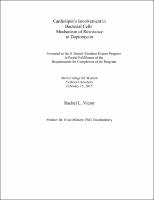Please use this identifier to cite or link to this item:
https://hdl.handle.net/20.500.12202/4197| Title: | Cardiolipin’s Involvement in Bacterial Cells’ Mechanism of Resistance to Daptomycin |
| Authors: | Victor, Rachel L. |
| Keywords: | Drug resistance in microorganisms. Cardiolipin. Antibiotics --Testing. Bacteria --Effect of drugs on. Gram-positive bacteria --Effect of drugs on. Anti-infective agents --Dose-response relationship. |
| Issue Date: | Feb-2015 |
| Publisher: | Stern College for Women |
| Abstract: | Daptomycin (DAP), an anionic lipopeptide, is used in treating infections such as MRSA caused by gram-positive bacteria that are resistant to many conventional therapies. DAP binds to the bacterial membrane in a calcium-mediated process and forms oligomers on the membrane’s surface that allows for rapid depolarization of the bacterial membrane by leakage of potassium ions. DAP’s activity is closely associated with the presence of dioleoylphosphatidylglycerol (PG), present in high amounts in bacterial cell membranes. In order to study DAP’s interaction with bacterial cells, Langmuir monolayers that have been previously shown to accurately represent cell membranes were constructed. Since studies have shown that membranes comprised solely of PG are not susceptible to DAP’s effects, the monolayers were comprised of a 1:1 mol ratio of PG and dioleoyl-phosphatidylcholine (PC). DAP was inserted into the monolayer and changes in surface pressure were monitored. Any difference between the initial and final surface pressure, known as the ∆π, was then measured to study DAP’s penetrating ability. Resistant bacterial membranes have exhibited the presence of lysylphophatidylglycerol (lysyl-PG) and tetraoleoyl-cardiolipin (CL). Our study looked at any change in DAP’s penetrating ability due to various molar ratios of CL present in the monolayer. When an increased percentage of CL was present in the membrane, DAP’s penetrating ability did indeed decrease. Although the mechanism of resistance (MOR) still requires further research, understanding DAP’s interactions with other phospholipids, such as CL, provides further insight into the effectiveness and penetrating ability of DAP. |
| Description: | The file is restricted for YU community access only. |
| URI: | https://hdl.handle.net/20.500.12202/4197 https://ezproxy.yu.edu/login?url=https://repository.yu.edu/handle/20.500.12202/4197 |
| Appears in Collections: | S. Daniel Abraham Honors Student Theses |
Files in This Item:
| File | Description | Size | Format | |
|---|---|---|---|---|
| Rachel-Victor.pdf Restricted Access | 455.49 kB | Adobe PDF |  View/Open |
This item is licensed under a Creative Commons License

